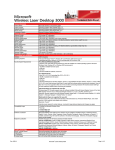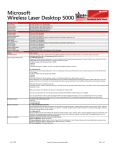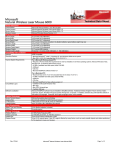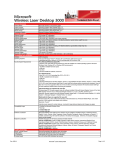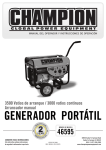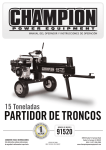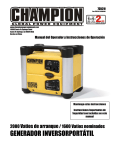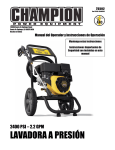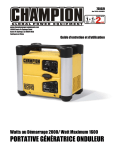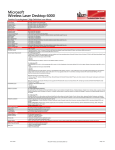Download Harbor Freight Tools 43149 User's Manual
Transcript
Metal Detector 43149 Set up and Operating Instructions Distributed exclusively by Harbor Freight Tools®. 3491 Mission Oaks Blvd., Camarillo, CA 93011 Visit our website at: http://www.harborfreight.com Read this material before using this product. Failure to do so can result in serious injury. Save this manual. Copyright© 2000 by Harbor Freight Tools®. All rights reserved. No portion of this manual or any artwork contained herein may be reproduced in any shape or form without the express written consent of Harbor Freight Tools. Diagrams within this manual may not be drawn proportionally. Due to continuing improvements, actual product may differ slightly from the product described herein. Tools required for assembly and service may not be included. For technical questions or replacement parts, please call 1-800-444-3353. Manual Revised 09c sonal injury. Do not use this product in areas where there might be underground electric lines or pipes buried at shallow depths. Never search in military zones where bombs or other explosives may be buried. Avoid striking any line known or suspected to be carrying electric power. Do not search any pipeline, particularly if it could contain a flammable gas or liquid. In areas of uncertain conditions, use reasonable caution before using the Tool. If there is any question about a condition being safe of unsafe, do not operate the Tool. Specifications Stem Length 15” - 27-1/2” Coil 8” Diameter Power Supply Qty 3, 9 Volt Batteries Built-in Battery Tester Audio 3 distinct sounds for different metals Weight 3.25 lb. Save This Manual You will need the manual for the safety warnings and precautions, assembly instructions, operating and maintenance procedures, parts list and diagram. Keep your invoice with this manual. Write the invoice number on the inside of the front cover. Keep the manual and invoice in a safe and dry place for future reference. 4. Keep the Tool clean. Wipe the housing after each use. The search coil is washable and can be fully submerged. Never submerge the control housing. Protect the control housing from rain, blowing surf and heavy mist. Disassemble the stem and wipe it clean after use in sandy areas. 5. Dress properly. Do not wear loose clothing or jewelry as they can be caught in moving parts. Protective, electrically nonconductive clothes and nonskid footwear are recommended when working. Wear restrictive hair covering to contain long hair. 6. Use the right tool for the job. Do not attempt to force a small tool or attachment to do the work of a larger industrial tool. There are certain applications for which this tool was designed. Do not modify this tool and do not use this tool for a purpose for which it was not intended. 7. Stay alert. Watch what you are doing, use common sense. Do not operate any tool when you are tired. Safety Warnings and Precautions WARNING: When using tool, basic safety precautions should always be followed to reduce the risk of personal injury and damage to equipment. Read all instructions before using this product! 1. Handle the Tool carefully at all times. Dropping the Tool can cause damage to circuit boards and the case, which can cause the product to work improperly. 2. Only use and store the Tool in normal temperature environments. Extremes in temperature can shorten the effectiveness of electronic devices and melt or damage plastic parts. 3. Avoid electrical shock. Any metal detector may discover underground power lines, explosives or other items which when struck could cause per- SKU 43149 For technical questions, please call 1-800-444-3353. Page 2 8. 9. Check for damaged parts. Before using any tool, any part that appears damaged should be carefully checked to determine that it will operate properly and perform its intended function. Check for alignment and binding of moving parts; any broken parts or mounting fixtures; and any other condition that may affect proper operation. Any part that is damaged should be properly repaired or replaced by a qualified technician. Do not use the tool if any switch does not turn On and Off properly. Replacement parts and accessories. When servicing, use only identical replacement parts. Use of any other parts will void the warranty. Only use accessories intended for use with this tool. Approved accessories are available from Harbor Freight Tools. defects or other reproductive harm. Wash hands after handling. (California Health & Safety Code § 25249.5, et seq.) 14. Warning: The warnings, cautions, and instructions discussed in this instruction manual cannot cover all possible conditions and situations that may occur. It must be understood by the operator that common sense and caution are factors which cannot be built into this product, but must be supplied by the operator. Unpacking When unpacking, check to make sure all parts shown on the Parts Diagram and Parts Lists are present. If any parts are missing or broken, please call Harbor Freight Tools at 1-800-444-3353. 10. Do not operate tool if under the influence of alcohol or drugs. Read warning labels on prescriptions to determine if your judgment or reflexes are impaired while taking drugs. If there is any doubt, do not operate the tool. Preparing to Operate Assembly 11. Maintenance. For your safety, maintenance should be performed regularly by a qualified technician. 12. People with pacemakers should consult their physician(s) before using this product. Electromagnetic fields in close proximity to a heart pacemaker could cause interference to, or failure of, the pacemaker. 13. WARNING: Handling the cord on this product will expose you to lead, a chemical known to the State of California to cause cancer, and birth SKU 43149 Figure 1 Figure 2 1. Turn the lock nut on the stem clockwise to loosen (see Figure 1). 2. Adjust the length of the stem so that when you stand upright with the tool held in your hand, the search coil is level with and about 1/2 to 2 inches above the ground (see Figure 2). For technical questions, please call 1-800-444-3353. REV 07f; 09c Page 3 3. Turn the stem’s lock nut counterclockwise to lock it in place. 4. Unscrew the knob on the search coil and take off the knobs and connector. Insert the stem and align the holes on the search coil bracket and the stem. Push the connector through the holes and tighten the knob. 7. Loosen the knob at the search coil’s end, then adjust the search coil’s end, then adjust the search coil to the desired angle. The search coil should be parallel with the ground. Tighten the knob enough to keep the search coil from rotating or wobbling. Figure 5 8. Figure 3 5. Wind the search coil cable around the stem. Make sure you leave enough slack in the cable to allow for adjustment when you are using the Tool on uneven ground (see Figure 3). To insert the arm support (see Figure 5), loosen the knob at the base of the handle. Insert the arm support and tighten the knob to hold the arm support in place. Battery Installation The Tool is powered by three, 9 Volt batteries. Battery installation is described below: Figure 4 6. Plug in the search coil’s plug into the search coil jack on the Tool’s control panel. Make sure that the pins on the plug align with the holes in the jack (see Figure 4). Note: The search coil’s plug fits into the connector only one way. Never force the plug; the plug could become damaged. To disconnect the plug, never pull on the cable; always take hold of the plug and pull it out of the connector. SKU 43149 Figure 6 1. If the Tool is on, turn MODE to OFF (see Figure 6). 2. Press the right battery compartment cover’s tab and slide the cover in the direction of the arrow (see Figure 7). 3. Place one 9 Volt battery into the battery compartment on top of the ribbon. Place For technical questions, please call 1-800-444-3353. Figure 7 Page 4 the battery so that it matches the polarity symbols (+ and -) that are marked inside the compartment. 4. Replace the right battery compartment cover. 5. Press the left battery compartment cover’s tab and slide the cover off in the direction of the arrow (see Figure 8). 6. Place two 9 Volt batteries into the battery compartment on Figure 8 top of the ribbons, matching the polarity symbols (+ and -) marked. Replace the left battery compartment cover. Note: The life of the batteries can be extended by using headphones (not included), which require less power than the built-in speaker. See the section on headphones below. CAUTION! Always remove old or weak batteries; old batteries can leak chemicals that can damage electronic parts. If you do not plan to use the Tool for a week or more, remove the batteries. Use only fresh batteries of the required size. Do not mix old and new batteries or different types of batteries. Testing Batteries Set the MODE to VLF (very low frequency). To test the batteries in the left battery compartment, set BATT TEST to B1. To test the battery in the right battery compartment, set BATT TEST to B2 (see Figure 9). Figure 9 Figure 10 If the pointer on the viewmeter is within the BATT scale’s green area, the batteries have enough power. If the pointer is not within the green area, the batteries need to be replaced (see Figure 10). Meter Adjustment Figure 11 Set MODE to OFF. Using a screwdriver, adjust the alignment control until the pointer lines up with O on the scale (see Figure 11). Test the battery power when the Tool does not turn on, or has weak volume, or will not tune properly or operates erratically. SKU 43149 For technical questions, please call 1-800-444-3353. Page 5 Earphone Use Basic Operation 1. Set the BATT TEST to OPERATE. 2. Hold the detector comfortably, then as shown in Figure 13, rotate MODE to the desired position. Figure 12 • Set it to VLF to test the battery power and adjust TUNE and GROUND (see directions below and on page 8). Stereo earphones (not included) can be connected to the Tool. Using earphones saves battery power and makes it easier to identify changes in the sound patterns. Earphones are connected to the ear jack on the side of the Control Housing (see Figure 12). Figure 13 • Set it to TR1 to detect extreme differences in metals, such as between gold and iron. The difference shows on the meter (iron as a ferrous metal, gold as a nonferrous metal). When using earphones, protect your hearing by: a.Set the volume to the lowest setting before you begin listening. Adjust the volume to a comfortable level. • Set it to TR2 to detect finer distinctions between metals. For example, between aluminum and gold. b.Never listen at extremely high volume levels; permanent hearing loss can result. c. Once the volume is set, do not increase it. Over time, your ears adapt to the volume level, so a volume level that does not cause discomfort might still damage your hearing. Tuning TUNE fine tunes the balance between the tool’s receiver and the transmitter circuitry, to provide consistent pointer and tone indications. Operation This tool distinguishes between ferrous and non-ferrous metals. Ferrous metals contain iron. Non-ferrous metals do not (examples: gold, silver, copper, platinum, aluminum, lead, and zinc). When the Tool senses a metallic object, the meter reading changes and the detector might sound a tone. The reaction depends on what metal is detected. SKU 43149 Figure 14 Figure 15 To Tune, do the following and see Figure 14 and 15, above: 1. Rotate VOLUME to the 10 o’clock position. 2. Set MODE to VLF. For technical questions, please call 1-800-444-3353. Page 6 3. Set GROUND, DISCRIMINATION, and SENSITIVITY to mid-range. the flat part faces upward (see Figure 17). Note: Never test on a floor inside a building, as it may have a type of metal present. 2. Figure 16 4. 5. Hold the search coil at least 1 foot away from the ground and any metal object. Hold down the red button on the handle and slowly rotate TUNE until the viewmeter pointer rests at or near 0 (see Figure 16). Note: The Tool will not detect without motion. You must move the object since you are not sweeping the Tool. 3. If the Tool detects the material, the NON-FERROUS and FERROUS indicators flash and the pointer moves to FERROUS or NON-FERROUS while the detector determines the type of metal it is detecting. If it detects nonferrous metal, it also sounds a tone. 4. If the Tool does not detect the material, check the battery power and verify that the search coil is properly connected. Also, you might need to fine tune the detector (see next page). As you use the Tool to search for items, you can fine tune by using the other control (see Fine Tuning the Tool on page 8). Note: To return the pointer to the center of the viewmeter at any time, simply press the red button on the handle. Testing the Tool You must first test the detector to find out how it reacts to different metals. It can be tested indoors or outdoors. Outdoor Testing 1. Locate an area outdoors where there is no metal present. Place a sample of the material to be tested (coin or gold ring) on the ground. 2. Set MODE to TR1. 3. With the search coil being held approximately 1 to 2 inches above the ground, slowly move the search coil over the area where you placed the sample. Sweep in a side to side motion as follows: Indoor Testing Figure 17 1. After removing watches, rings or any other metal jewelry, place the detector on a wooden or plastic table. Adjust the search coil’s angle so that SKU 43149 Set MODE to TR1. Move a sample of the material being tested (example: coin or gold ring) about 2 inches above the search coil. For technical questions, please call 1-800-444-3353. Page 7 Fine Tuning Once you practice with the unit, you can fine tune it to make it more selective in what is found. Adjusting SENSITIVITY Figure 18 4. Sweep slowly to avoid missing targets. Never raise the sweep coil while sweeping; sweep back and forth as if it was a pendulum (see Figure 18). 5. If the Tool detects the item, it sounds a tone and the pointer moves to the type of metal it found. After detecting metal, switch MODE TR1 to TR2 to determine the quality of the metal. If nothing was detected, try again (make sure the search coil is being moved properly). 6. 7. 8. To adjust the search coil’s ability to detect objects at different depths in the ground, rotate SENSITIVITY between MIN and MAX. For maximum detection depth, leave SENSITIVITY set as high as possible. If the Tool begins to “chatter”, decrease SENSITIVITY until the noise stops. Adjusting GROUND For accurate operation, it is critical that you take the time to correctly set GROUND. GROUND tunes out false signals from mineralized soil. The detector will respond strongly when it detects most valuable metal objects. If the signal does not repeat after being swept over the target a few times, the target is probably junk metal. False signals can occur from electrical interference, large, irregular pieces of junk metal, or finding trash on the ground. False signals usually occur broken or are non-repeatable. After finding a metal item, wait a few seconds after the tone stops before continuing; this allows the detector time to reset. You can also press the red button on the handle to return the pointer to the center of the viewmeter. SKU 43149 Figure 19 To set GROUND: 1. Set MODE to VLF and lower the search coil to 1/2 to 2 inches above the ground. 2. If the pointer swings to the right, turn GROUND to the left. If the pointer swings to the left, turn GROUND to the right. 3. Lift the search coil about 12 inches from the ground and press the red button on the handle. The pointer will return to the center. Repeat these three steps until the pointer stays close to the center each time you lower the search coil to the ground. For technical questions, please call 1-800-444-3353. Page 8 4. After setting GROUND the Tool is ready for the soil type at that particular site. It will not need to be reset until you move to a new location. Adjusting DISCRIMINATION Discrimination is the Tool’s ability to differentiate between types of metal. This setting determines whether the detector will distinguish between different types of ferrous and non-ferrous metals. If MODE is set to TR2, start with DISCRIMINATION set to mid-range. While the Tool is being used, adjust DISCRIMINATION to the best position. As you set it higher, the detector becomes more sensitive to the differences between large aluminum and gold pieces, for example, but other valuable items such as coins and small rings, might be overlooked. As you set DISCRIMINATION to higher levels, the detector first does not detect small pieces of silver paper, then thick foil, and finally metal objects like cola pull tabs. Each time you change areas, you must reset DISCRIMINATION. False Signals and Detection Hints As you sweep the search coil back and forth over the ground surface, you will recognize the difference between signals that occur at random and signals that are stable and repeatable. The key is to dig only for those targets that produce a strong, repeatable signal. This will prevent you from wasting time focusing on trash induced signals. No metal detector is totally accurate. Many conditions influence the success of metal detection. Among the factors that influence results are the angle at which the object rests in the ground, the depth of object, the amount of iron the object contains and the size of the object. To accurately pinpoint a target: 1. Once the detector detects a target that is buried, continue to sweep the search coil over the target in a narrowing side-to-side motion. 2. Stop the search coil directly over the spot on the ground. Then move the search coil straight forward away from you and straight back towards you. Make a mental note of the exact spot on the surface where the detector beeps. Repeat these steps in an X pattern. The target should be directly below the X at the area where the loudest response is heard. Troubleshooting Problem False signals are being displayed Once a target is found, the display does not show the correct metal type SKU 43149 Suggestion for Cure 1. Sweeping too fast or at the wrong angle. 2. Heavily oxidized metals are detected. Pinpoint the target from several different angles. If the detector does not display and sound the same signal each time, the target is probably heavily oxidized metal. 1. May be more than one target in the area. 2. If target is heavily oxidized, an incorrect reading may occur. This does not signify a problem with the detector. 3. It may be a type of metal which is not recognizable to the detector. For technical questions, please call 1-800-444-3353. Page 9 Parts List Part 1 2 3 4 5 6 7 8 9 10 11 12 13 14 15 16 17 18 19 20 Description Mfr’s Part No. Control Box Top SQC6.116.042 Meter M3006 Loud Speaker YD-50 16 ohm 0.25 W Fixing Board SQC8.610.154 Screws ST2.9 x 6 GB845-85 Lining Board SQC8.683.031 Main PCB SQC2.908.526 Screws ST2.9 x 8 GB845-85 Handle SQC6.465.033 Screws ST3.9 x 16 Nut M6 x 0.75 GB808-76 Nut M8 x 0.75 GB808-76 Control Knob SQC8.337.334 Control Box Button SQC6.116.044 Potentiometer B-10K R1710N16K Nut M6 x 0.75 GB808-76 Control Knob SQC8.337.330 Stereo Earphone PCB SQC5.566.003 Nut M6 x 0.5 Aluminum Stem (19mm) SQC8.009.002 Part 21 22 23 24 25 26 27 28 29 30 31 32 33 34 35 36 37 38 39 Description Stem Lock Ring Stem Screw M3 x 10 Stem Lock Nut Stem Lock Ring Screws M4 x 28 Cover (Stem) Cover (Large) Cover (Small) Search Head Head Knob (Screw) Head Knob (Nut) Bracket Socket PCB Aluminum Stem Board Flat Washer Spring Washer Nut M3 Mfr’s Part No. SQC8.225.012 SQC6.336.001 GB819.85 SQC8.225.011 SQC8.220.081 SQC7.852.078 SQC6.170.030 SQC6.170.031 SQC5.939.000 SQC6.354.021 SQC6.354.022 SQC6.154.001 SQC5.566.004 SQC8.009.001 SQC8.610.157 GB848-85-3 GB859-87-3 GB6172-86 PLEASE READ THE FOLLOWING CAREFULLY THE MANUFACTURER AND/OR DISTRIBUTOR HAS PROVIDED THE PARTS DIAGRAM IN THIS MANUAL AS A REFERENCE TOOL ONLY. NEITHER THE MANUFACTURER NOR DISTRIBUTOR MAKES ANY REPRESENTATION OR WARRANTY OF ANY KIND TO THE BUYER THAT HE OR SHE IS QUALIFIED TO MAKE ANY REPAIRS TO THE PRODUCT OR THAT HE OR SHE IS QUALIFIED TO REPLACE ANY PARTS OF THE PRODUCT. IN FACT, THE MANUFACTURER AND/OR DISTRIBUTOR EXPRESSLY STATES That ALL REPAIRS AND PARTS REPLACEMENTS SHOULD BE UNDERTAKEN BY CERTIFIED AND LICENSED TECHNICIANS AND NOT BY THE BUYER. THE BUYER ASSUMES ALL RISK AND LIABILITY ARISING OUT OF HIS OR HER REPAIRS TO THE ORIGINAL PRODUCT OR REPLACEMENT PARTS THERETO, OR ARISING OUT OF HIS OR HER INSTALLATION OF REPLACEMENT PARTS THERETO. Note: Some parts are listed and shown for illustration purposes only and are not available individually as replacement parts. WARNING! Service and maintenance should only be performed by a qualified technician. SKU 43149 For technical questions, please call 1-800-444-3353. Page 10 Parts Diagram SKU 43149 For technical questions, please call 1-800-444-3353. Page 11











